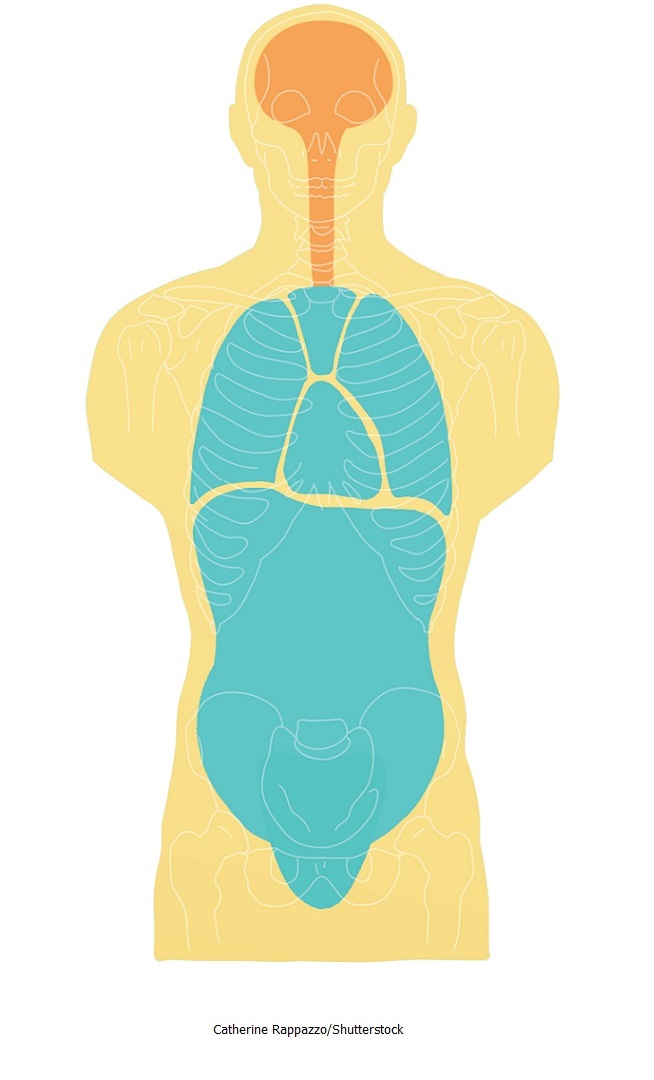
This body cavities and membranes quiz will test your knowledge so that you can prepare for your anatomy and physiology exams. The body contains several cavities and membranes, which contain and protect various organs.

Don’t forget to check out the anatomy notes for body cavities and membranes, as well as more lectures on anatomy and physiology topics.
This body cavities and membranes quiz will test your knowledge on anatomy and physiology topics for exams.
(NOTE: When you hit submit, it will refresh this same page. Scroll down to see your results.)
1. The body has two major cavities and several minor cavities.
The answer is a, true. The body has two main cavities: the dorsal cavity and the ventral cavity. These can be subdivided into other cavities, such as the thoracic, cranial, vertebral, and abdominopelvic cavities. There are also minor cavities in the body, such as the nasal or oral cavity.
2. Which structure below is not found in the thoracic cavity?
a. Pleural cavity
b. Pericardial cavity
d. Peritoneal cavity
The answer is d, peritoneal cavity. The peritoneal cavity is found in the abdominopelvic cavity.
3. The dorsal cavity includes the cranial and thoracic cavity.
The answer is b, false. The dorsal cavity contains the cranial cavity and the vertebral cavity. The thoracic cavity is located in the ventral cavity.
4. Which landmark separates the thoracic cavity from the abdominopelvic cavity?
a. The peritoneum
b. The diaphragm
The answer is b, the diaphragm. The diaphragm is a muscle that helps us breathe, and it physically separates the thoracic cavity from the abdominopelvic cavity. The dorsal cavity is continuous, which means it does not have a physical separation. The abdominal cavity is also continuous with the pelvic cavity.
5. The three membranes found in the dorsal cavity that cover the spinal cord and brain are collectively called what?
a. Peritoneal membranes
c. Serous membranes
d. None of the above
The answer is b, Meninges. These three membranes cover the central nervous system, and they consists of the dura mater, arachnoid, and pia mater. When this membrane becomes inflamed, it is called meningitis.
6. In a serous membrane, what is the name of the membrane portion that touches and surrounds the organ?
a. Visceral serosa
b. Parietal serosa
The answer is a, visceral serosa. This is the portion of the membrane that touches or surrounds the organs (also called viscera). The outside portion of the membrane is called the parietal serosa. The watery fluid between the visceral and parietal membrane is called serous fluid, and it makes up the “cavity” in each membrane.
7. What is the name of the serous membrane that surrounds the left lung?
a. Pleural cavity
The answer is b, Pleura. This was a tricky question! The pleural cavity is the name of the cavity found within the pleura membrane (the cavity is the part that contains the serous fluid). However, the membrane layer itself that surrounds the lung (parietal and visceral portions) is called the “pleura.” If the question had asked the name of the cavity that houses the lung, pleural cavity would have been correct. The keyword in the question was “membrane.” The pericardium membrane contains the pericardial cavity, and the peritoneum membrane contains the peritoneal cavity.
8. Which cavity is not found in the ventral cavity?
The answer is a, Vertebral. The vertebral and cranial cavities are found in the dorsal cavity, not the ventral cavity.
9. Which cavity houses the liver?
a. Pericardial cavity
b. Ventral cavity
c. Dorsal cavity
d. Abdominal cavity
e. Answers b and d
The answer is e: the ventral cavity and the abdominal cavity (which is found in the ventral cavity) contain the liver.
10. What is not found in the pelvic cavity?
a. Reproductive organs
c. Parts of the large intestine (sigmoid colon and rectum)
The answer is b, the stomach. The pelvic cavity is found within the pelvic (hip) bone. It contains the reproductive organs, the rectum (and sigmoid colon), and the bladder.
Don’t forget to tell your friends about this quiz by sharing it your Facebook, Twitter, and other social media. You can also take more fun nursing quizzes.
*Disclaimer: While we do our best to provide students with accurate and in-depth study quizzes, this quiz/test is for educational and entertainment purposes only. Please refer to the latest NCLEX review books for the latest updates in nursing. This quiz is copyright RegisteredNurseRn.com. Please do not copy this quiz directly; however, please feel free to share a link to this page with students, friends, and others.